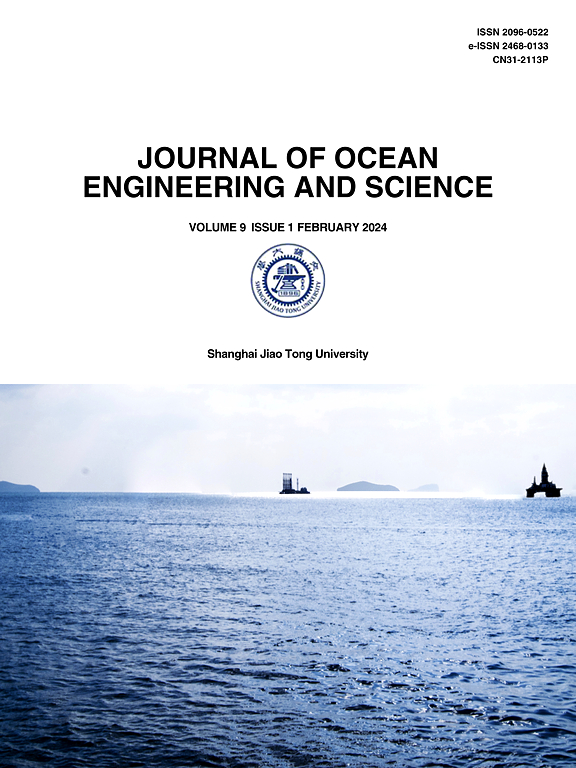高阶格式在非定常流动模拟中的应用:与二阶工具的比较
IF 11.8
1区 工程技术
Q1 ENGINEERING, MARINE
引用次数: 0
摘要
本工作的目的是研究高阶格式模拟非定常湍流的效用和有效性。为了实现这一目标,从两个方面进行了研究:(i)不同数值格式使用同一组网格精确模拟湍流问题的能力;(ii)求解不同网格类型(六面体、四面体和多面体单元)湍流统计的高阶格式的准确性和稳定性。模拟采用三阶格式对控制方程进行空间离散化,同时采用一种广泛使用的二阶求解器(即pisoFoam)进行比较。本研究考虑了二维泰勒-格林涡旋(2D TGV)问题在Re=100,1600和Re=10000时流过球体的典型情况,以解决上述两个关键问题。对于TGV情况,高阶模型显著提高了数值精度和收敛速度,使不同网格类型下的数值耗散减少了近1/10。在后一种情况下,无论网格类型如何,高阶格式与大涡模拟(LES)都能准确预测涡结构和流动不稳定性。然而,pisoFoam被发现对网格类型很敏感,这导致流场中由于数值噪声而不是流动物理而产生许多非物理结构,特别是对于四面体单元。此外,对于典型的低阶和高阶流动统计量,与常规方案相比,该模型预测的数值结果与参考数据的一致性更好,并且对网格类型的依赖较小。此外,高阶求解器获得的能谱能准确地捕捉到开尔文-亥姆霍兹(K-H)不稳定性和旋涡脱落频率,而这些重要特征在传统的低阶模型中不太明显。本文章由计算机程序翻译,如有差异,请以英文原文为准。
Utility of high-order scheme for unsteady flow simulations: Comparison with second-order tool
The objective of this work is to investigate the utility and effectiveness of the high-order scheme for simulating unsteady turbulent flows. To achieve it, the studies are conducted from two perspectives: (i) the ability of different numerical schemes to accurately simulate turbulence problems using the same set of meshes; and (ii) the accuracy and stability of higher-order schemes for solving turbulence statistics for different mesh types (hexahedral, tetrahedral, and polyhedral cells). The simulations employ the third-order scheme for spatial discretization of the governing equations, while a widely-used second-order solver, namely pisoFoam, is employed for comparison. This study considers the canonical cases of the two-dimensional Taylor-Green vortex (2D TGV) problem at and flow past a sphere at to address the aforementioned two key issues. For the TGV case, the high-order model significantly improves the numerical accuracy with convergence rates and reduces the numerical dissipation of nearly 1/10 of pisoFoam on different meshing types. In the latter case, the high-order scheme with large-eddy simulation (LES) accurately predicts the vortex structures and the flow instability, regardless of grid type. However, pisoFoam is found to be sensitive to mesh types, which results in numerous non-physical structures in the flow field due to numerical noise rather than flow physics, particularly for tetrahedral cells. Furthermore, for the typical low- and high-order flow statistics, the numerical results predicted by the present model show better agreement with the reference data and have less dependence on the type of grids compared with the conventional scheme. In addition, the obtained energy spectrum by the high-order solver accurately captures the Kelvin-Helmholtz (K-H) instability and the vortex shedding frequency, while these important features are less pronounced by the traditional low-order model.
求助全文
通过发布文献求助,成功后即可免费获取论文全文。
去求助
来源期刊

Journal of Ocean Engineering and Science
Multiple-
CiteScore
11.50
自引率
19.70%
发文量
224
审稿时长
29 days
期刊介绍:
The Journal of Ocean Engineering and Science (JOES) serves as a platform for disseminating original research and advancements in the realm of ocean engineering and science.
JOES encourages the submission of papers covering various aspects of ocean engineering and science.
 求助内容:
求助内容: 应助结果提醒方式:
应助结果提醒方式:


